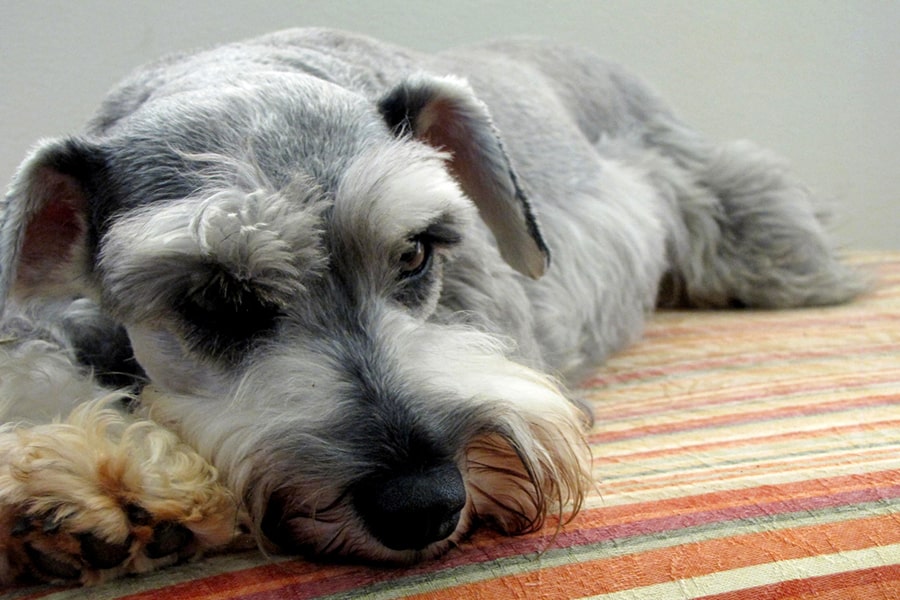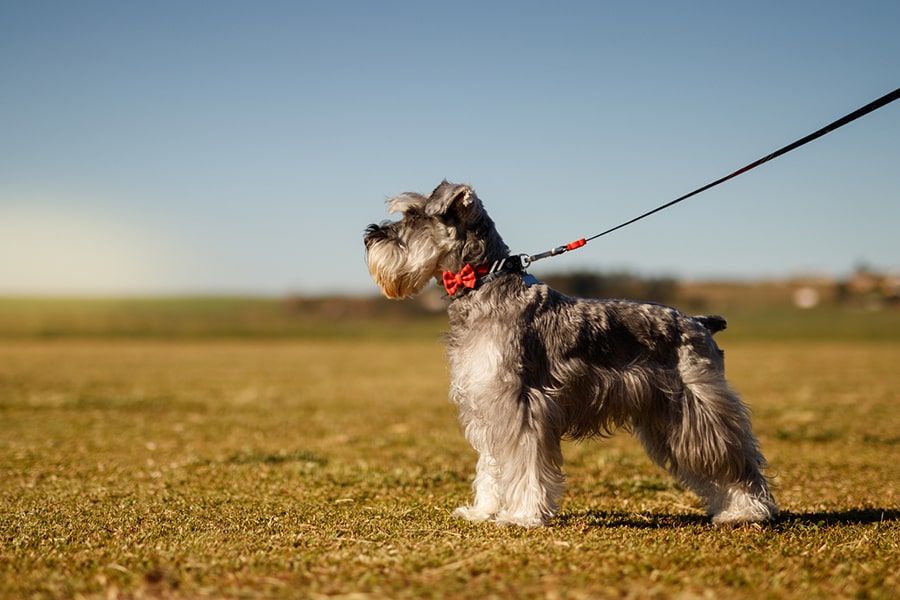Frequently Asked Questions About Spaying and Neutering Pets
Should you spay or neuter your pet? From health and behavioral benefits to managing animal overpopulation, get the facts in our spaying and neutering guide.
Miniature Schnauzers are spunky, little dogs that often have big and boisterous personalities. Whether it’s curling up on the couch or going for a walk, these dogs can be both lazy and active, so long as they get to spend time with their family. Read on to learn more about this German terrier dog.
Although not entirely dependent enough to earn themselves the nickname of “Velcro dog,” Miniature Schnauzers prefer to spend their time in the company of loved ones. These dogs adore their family, and it is not uncommon for them to have a favorite person with whom they will spend the most time. Overall a friendly breed, Miniature Schnauzers can still be hesitant around strangers, but once they realize that you have given this new person the stamp of approval, they too will quickly warm up to this new friend.
The Miniature Schnauzer temperament is lively, alert, and outgoing, making them quite compatible with living with kids, especially when they grow up in the home together. However, it is essential that children are taught how to interact with a dog safely. They should never pull on a dog’s tail or ears, bother them while eating, or try to climb on their back. Be sure to monitor all interactions your dog has with children, especially those of a younger age.
Unlike many other terriers, the Miniature Schnauzer gets along well with other dogs. However, when around much larger canines, Mini Schnauzers may think they are superior and may be assertive towards the other dogs. Be mindful of this behavior because you may need to bail your pal out of the situation.
When you introduce your dog to another, be sure to take your time with the introduction and try to make the interaction a positive experience. The same applies if your Miniature Schnauzer will be living with a cat.
On the other hand, it is not recommended that you have a dog of this breed living in the same house as small animals, such as rabbits, gerbils, or hamsters. If you do, it is vital that you keep your smaller pets in a secure room, away from your dog. Miniature Schnauzers were originally bred to be ratting dogs, so it is their instinct to hunt small prey.
As is true with most terriers, Miniature Schnauzers will bark quite often, even at random noises. On the plus side, this alertness does make them excellent watchdogs. Years ago, farmers used to pair Miniature Schnauzers up with German Shepherds and, at any sign of trouble, the little watchdog could alert the big guard dog.
If you live in an apartment or are overall not a fan of constant barking, you can start training your dog early on that barking isn’t a necessary response to every unusual noise. It may take some time and persistence, but having a quieter home is typically worth the work.

Miniature Schnauzers were originally from Germany, where they were bred to be ratters and watchdogs on farms. These dogs are said to be the only terriers that did not originate from the European Isle breeds. They are also a separate breed from the Standard Schnauzer.
Developed in the late 19th century, people were breeding small Standard Schnauzers with other breeds such as Poodles, Miniature Pinschers, and Affenpinschers, the result being the Miniature Schnauzer. The first recorded Mini Schnauzer was a black female named Findel.
Like many other dog breeds, both World Wars negatively affected Mini Schnauzers’ population, particularly in Europe. Thankfully, these dogs were brought to the United States in 1924, and they quickly gained popularity.
Although their popularity has risen and fallen throughout the years, these dogs continually rank in the top 20 most popular dog breeds in the U.S. Today, they are still a common breed worldwide and remain a favorite among families.
In German, the name Schnauzer means “small beard.”
The most distinct feature of the Mini Schnauzer is their facial hair. Sporting bold eyebrows and a wise beard, it’s often easy to spot a dog of this breed in a crowd. Although many years ago it was common to find these dogs in practically any color, today they are mainly just four colors—black, black and silver, pepper and salt, and white.
Before adopting a Miniature Schnauzer, most pet parents have some questions about the breed. Common questions include:
On average, these dogs can weigh between 11-20 pounds. Height-wise, they stand 12-14 inches at their shoulder.
The typical lifespan of a Mini Schnauzer is 12-14 years. However, many factors can affect a dog’s life expectancy, including their diet, living environment, exercise plan, and overall health. If your dog is in general good health, it is not unheard of for Mini Schnauzers to live past 14 years.
Yes, Mini Schnauzers are hypoallergenic, mainly because they hardly shed. That being said, although low-shedding dogs produce fewer allergens, the same proteins in a dog’s hair that cause allergic reactions can also be found in a dog’s saliva and skin. This means that for some dog-allergy sufferers, hypoallergenic dogs can still cause a reaction.
Picking the dog breed that best compliments your lifestyle can be a difficult choice, so it is essential to ask yourself some questions before adopting a new dog.
Before introducing a new dog into your home, it’s helpful to look at your lifestyle honestly. Although some schedules aren’t compatible with certain types of dog breeds, sometimes people are willing to change their habits to benefit their new pal.
Before adopting a dog, it’s also important to consider the financial responsibility of being a dog parent—do you know how much it costs to have a dog?
When it comes to Miniature Schnauzers, the good news is that they barely shed. The bad news is that their coat requires quite a bit of attention. These dogs have a double coat, with a soft undercoat and a wiry outercoat.
Mini Schnauzers typically need to be groomed about every six weeks, and you can choose to either have their coat stripped or clipped. Stripping, which involves removing the loose, dead hair, can be a slow, tedious process. Preferring an easier, more manageable route, most Schnauzer parents prefer their dog’s coat to be clipped.
No matter which grooming style you choose, it is essential that you maintain a schedule and do not allow your dog’s hair to get too long—the longer their coat, the higher chance of tangles and mats forming. Around the time that their hair needs trimmed, your dog will most likely also be due for a bath.
About once a month, your pal’s nails will need to be trimmed. Their ears should be checked weekly for redness or a bad odor, which could be the sign of an ear infection. Whenever their ears appear dirty, clean them out with a cotton ball and dog-safe ear cleaning solution. Just be sure never to use a cotton swab, as these could accidentally hurt your dog’s ears.
On a weekly basis, it is recommended that you brush your dog’s pearly whites with dog-safe toothpaste—multiple times a week is even more beneficial.
Besides a regular grooming routine, your Mini Schnauzer will also require daily care, including an age-appropriate and nutritious diet. Besides providing healthy food, it is equally important to give your dog the correct amount of food per meal. Overeating can quickly lead to weight gain. Obesity can affect any dog breed, and it can be the precursor to a long list of other health issues.
Daily care for a Mini Schnauzer also requires exercise. Don’t be mistaken by their small size—these dogs are not made to be lazy lapdogs.
It’s vital that your dog receives one or two walks a day, a chance to run around, or even a chance to play inside. Suppose these dogs do not receive enough opportunities to burn off their extra energy. In that case, destructive tendencies are often the result—their favorite is shredding any paper from wrapping paper to toilet paper.

Since Miniature Schnauzers are intelligent and energetic dogs, they are typically eager to learn new tricks and commands. It is crucial to begin training your dog as early as possible. Otherwise, you may have an unruly or bullheaded adolescent on your hands. It can be helpful to encourage your dog with food, toys, and positive praise during your training sessions. You may also find that short sessions are best so that you don’t lose your dog’s attention.
Besides working on your dog’s behavior, teaching your dog new tricks can also provide much-needed mental stimulation. Just like humans, it can be beneficial for canines to have daily brain exercises.
Going hand in hand with training is socialization. It’s equally as important to begin socializing your pal at a young age. Introducing them to new people, places, and animals can help your dog become better acclimated to new situations. Not to mention, being well socialized can positively influence your dog’s personality and temperament.
Just as you would reward your dog for listening to a command, be sure to give praise and reward your dog when they have good interactions with others or when they remain behaved in a new environment.
Although Miniature Schnauzers are a relatively healthy breed, they are still susceptible to some health issues. According to our claims data,** the top five conditions that affect this breed include,
Even though these health problems are common in the Mini Schnauzer breed, there is no guarantee that your dog will develop any or all of these listed above. One of the best ways to keep your dog in tip-top shape is to establish them with a local veterinarian soon after adoption. As your pup grows, it remains vital to schedule annual appointments so that your pal can continue to receive checkups throughout their entire life.
Once you’ve adopted your new Mini Schnauzer, you then have to make the difficult decision of picking a name. To help you with this process, we’ve compiled a list of possible Mini Schnauzer names, all inspired by their country of origin, Germany.
With an adorable new member of the family, be sure to take piles of pictures and share your love of Miniature Schnauzers with everyone you can.
**Internal Claims Data, 2015-20
The information presented in this article is for educational and informational purposes only and does not constitute or substitute for the advice of your veterinarian.